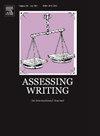使用自然语言处理评估十年级论文中的学术语言
IF 5.5
1区 文学
Q1 EDUCATION & EDUCATIONAL RESEARCH
引用次数: 0
摘要
从广义上讲,学术语言是教育和学术话语中常用的一套词汇语法规范和语域。在写作中掌握学术语言是写作指导和评估的一个重要方面。本研究的目的是使用自然语言处理(NLP)工具来检查与学术语言相关的特征在多大程度上解释了由10年级学生撰写的基于源的议论文(n = 20,820)的大型语料库中人为分配的写作质量分数的差异。使用NLP工具,我们从论文中识别并计算出与学术语言的词汇、句法、衔接和修辞特征相关的语言特征。与先前的研究结果一致,层次线性回归的结果显示,当控制文章长度时,人工智能特征解释了8 %的写作质量方差。最重要的人工智能特性包括与源文本的衔接、学术措辞和全局衔接。讨论了在写作评估和自动写作评估(AWE)系统中整合nlp产生的人工智能测量的含义。本文章由计算机程序翻译,如有差异,请以英文原文为准。
Assessing academic language in tenth grade essays using natural language processing
Broadly defined, academic language (AL) is a set of lexical-grammatical norms and registers commonly used in educational and academic discourse. Mastery of academic language in writing is an important aspect of writing instruction and assessment. The purpose of this study was to use Natural Language Processing (NLP) tools to examine the extent to which features related to academic language explained variance in human-assigned scores of writing quality in a large corpus of source-based argumentative essays (n = 20,820) written by 10th grade students. Using NLP tools, we identified and then calculated linguistic features from essays related to the lexical, syntactic, cohesion, and rhetorical features of academic language. Consistent with prior research findings, results from a hierarchical linear regression revealed that AL features explained 8 % of variance in writing quality when controlling for essay length. The most important AL features included cohesion with the source text, academic wording, and global cohesion. Implications for integrating NLP-produced measures of AL in writing assessment and automated writing evaluation (AWE) systems are discussed.
求助全文
通过发布文献求助,成功后即可免费获取论文全文。
去求助
来源期刊

Assessing Writing
Multiple-
CiteScore
6.00
自引率
17.90%
发文量
67
期刊介绍:
Assessing Writing is a refereed international journal providing a forum for ideas, research and practice on the assessment of written language. Assessing Writing publishes articles, book reviews, conference reports, and academic exchanges concerning writing assessments of all kinds, including traditional (direct and standardised forms of) testing of writing, alternative performance assessments (such as portfolios), workplace sampling and classroom assessment. The journal focuses on all stages of the writing assessment process, including needs evaluation, assessment creation, implementation, and validation, and test development.
 求助内容:
求助内容: 应助结果提醒方式:
应助结果提醒方式:


